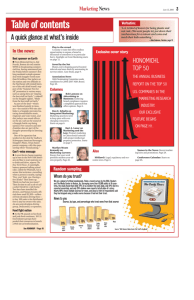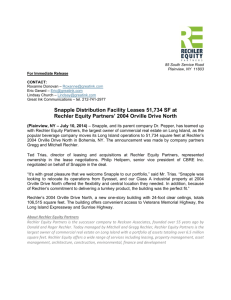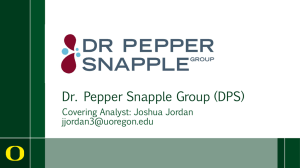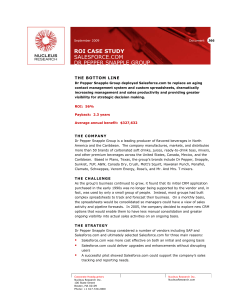Snapple group paper with Concl
advertisement
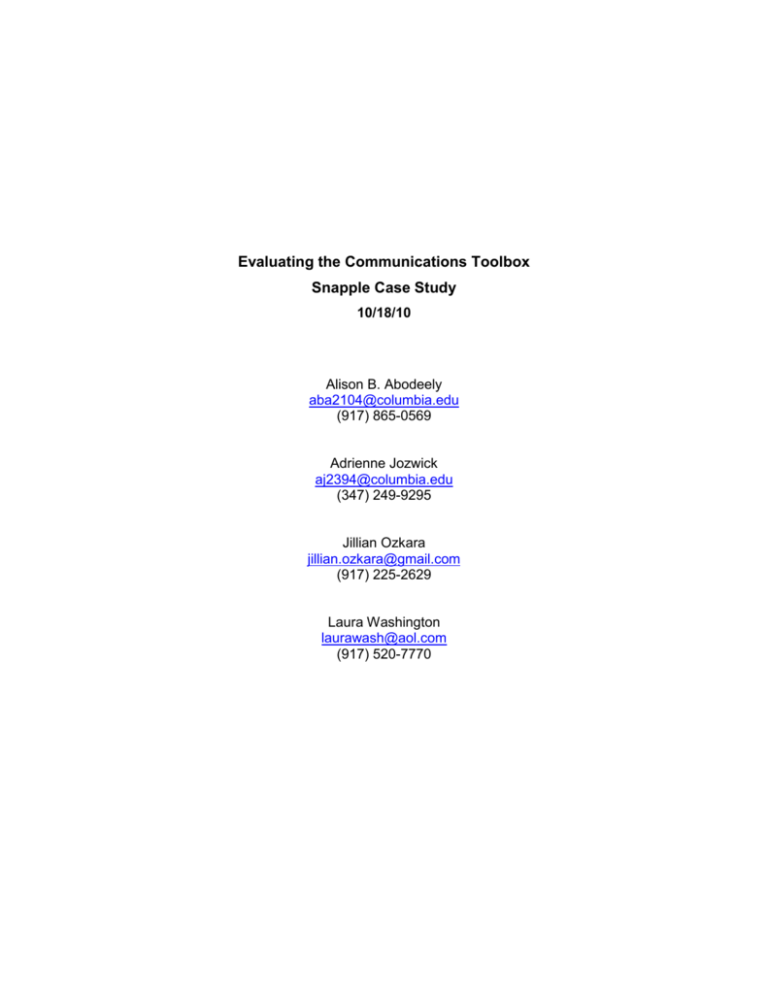
Evaluating the Communications Toolbox Snapple Case Study 10/18/10 Alison B. Abodeely aba2104@columbia.edu (917) 865-0569 Adrienne Jozwick aj2394@columbia.edu (347) 249-9295 Jillian Ozkara jillian.ozkara@gmail.com (917) 225-2629 Laura Washington laurawash@aol.com (917) 520-7770 Background In 1972, New Yorkers Leonard Marsh, Hyman Golden, and Arnold Greenberg started a line of appleflavored beverages made from all-natural ingredients sold under the brand name “Snapple.” The company branched out to other fruit and tea-based flavors and sold their product through a network of small, family-owned distributors that serviced convenience stores, pizza shops, street vendors, and gas stations along the Northeast corridor. Snapple was the first company to offer non-carbonated, ready-to-drink beverages. It was also first to sell its drinks in single-serving glass bottles rather than in the aluminum cans used by other beverage companies. Snapple’s quirky, offbeat brand was evident in its packaging—bright labels promoting the “all-natural” beverage “made from the best stuff on earth.” Its promotions were just as quirky, ranging from using former truck dispatcher Wendy Kaufman as spokesperson to inviting Snapple drinkers to day-long Snapple Conventions for Snapple-themed fun and games. Snapple’s products attracted health-conscious consumers who enjoyed the exotic flavors with whimsical names. The brand led the alternative beverage category by 1992, when the founders sold control of the company to a private investment bank. In 1994, with sales of $674 million, Snapple was sold to Quaker Oats for $1.7 billion. Though Quaker had a track record of success in growing the sports drink Gatorade, under its leadership, Snapple’s sales declined 35 percent over a 4-year period. In 1997, its brand in decline due to poor distribution channels and uninspiring flavors and marketing, Snapple was acquired by Triarc for $300 million. Business Objective Triarc’s business objective for the Snapple brand is to grow its market share of the alternative beverage segment by 9 percent in developed markets and by 5 percent in undeveloped markets in 1998. To do so, Triarc will have to reverse the 4-year sales slide by improving Snapple’s family-run distribution network and increasing sales to niche retailers. At the same time, it will grow supermarket distribution in developed markets. Triarc will also foster growth by creating new flavors and marketing them locally. Marketing will be a key element in Triarc’s efforts to strengthen the brand and reconnect Snapple to its core consumers. Consumer Profile Kimberly is a 27-year-old elementary school teacher living in the Fremont district of Seattle. Often called "The Artists' Republic,” Fremont is Seattle’s mecca for art and culture enthusiasts. It has a mix of artists, students, and young professionals who are characterized as diverse, eccentric, and unpretentious. Befitting Kimberly’s personality, Fremont strikes a perfect balance between urban and suburban—not for the idle, 1 yet not over-stimulated by fast-paced city life. It is populated with boutiques, galleries, eateries ranging from quick take-out joints to higher-end restaurants, and a local movie theater. Kimberly is creative, intelligent, compassionate, independent, and “down-to-earth.” Friends describe her as not too introverted, not too extroverted. She surrounds herself with like-minded individuals and enjoys visiting museums, attending local music festivals, and watching movies. She does relish her alone time for self-reflection and, of course, for tuning into her favorite TV shows—Friends and re-runs of Seinfeld. Kimberly is spiritual but prefers the peaceful outdoors to attending weekly services. Though she’s not a sports enthusiast, she does maintain a healthy lifestyle through yoga at her neighborhood studio, jogging around the nearby lake, and going on leisurely bike rides along the beach. Her adventurous streak takes her to the rainforests of the Olympic National Park, hikes at Mount Baker, and sails through the San Juan Islands. Kimberly loves teaching, helping shape young lives and likewise expanding her own horizons. She is considering the next step in her career, looking into advanced degree programs. As an art enthusiast, she leans toward postmodernism for its inventiveness, sculptural forms, contextualism, and its rejection of strict rules. She enjoys being challenged on an intellectual level and reads poetry and literature, studies architecture, and attends modern dance programs. Her love of art is evident in her teaching style. Believing it to be a powerful educational tool, especially for children, she often incorporates it into her curriculum. During her free time, she volunteers at the Fremont Art Council (FAC), an organization dedicated to fostering a collaborative environment for celebrating the arts and local artists. Like the FAC, Kimberly believes that art “helps build stronger communities…and helps make magic happen that otherwise would leave Fremont a less colorful place.”1 Snapple is an integral part of Kimberly’s daily routine. On her way into work each morning, she stops at Marketime Food, her neighborhood market, to pick up a single-size bottle. Marketime sells a little of everything—from items from local producers (organic fruits and vegetables, artisan breads, sandwiches, etc.) to commercial beverages and grab-and-go snacks (candy, chips, sodas, etc.). It caters to individuals like Kimberly who are conscious about their health and well-being, but are not extremist. While Kimberly finds teaching grade school rewarding, it is strewn with taxing moments—from fussy children to “over-involved” parents. Recess is a blissful break from daily temper tantrums and squabbles. When Kimberly isn’t supervising recess, she grabs her Snapple and dashes to the break room where she slumps into a chair and raises her weary feet. “It’s that pop,” she explains. “When I twist off the cap, it makes this distinct sound—like the bell telling kids when it’s time for recess. The pop speaks to me, telling me that it’s my time now. Drinking Snapple calms me, but also makes me feel creative and even playful. I know I’m doing something good for myself.” 1 Fremont Arts Council, website, www.fremontartscouncil.org 2 Though Snapple doesn’t give Kimberly a complete sense of escapism, it does make her feel at ease and rejuvenated. The smooth, lively flavors are invigorating. She refrains from carbonated sodas that tend to weigh her down. From the vibrant label to the exotic tastes, drinking Snapple is much like her life in Fremont—a colorful, enriching experience. Kimberly slowly sips the tea to savor the moment. After swallowing that last drop, she feels back in control, poised and ready to continue on with her day. Communications Objective and Strategy Triarc’s communications objective is to inspire 10 percent of people aged 18-35 in developed markets to drink Snapple daily in 1998, spending $10 per week on the beverage, and to get 5 percent of the target audience in undeveloped markets to try Snapple at least once. The communications objective is closely tied to the business objective—by increasing consumption, sales of Snapple will increase, which will ultimately benefit the brand. Today, the competitive environment in beverages is saturated with companies making outrageous claims that their products will provide some unique benefit consumers must have. However, no drink has ever impelled anyone to run faster, allowed them to sing better, or given them wings. On the other side of the madness is water. Granted, people need it to live, but does society really crave it? During a long, hard day of work, do people really have the image in the back of their minds of being at home, sitting back, and cracking open an ice-cold, refreshing, flavorful bottle of…water? Somewhere in the sea of bland water types and drinks that turn people into Superman, Michael Jordan, or the Spice Girls stands Snapple. Snapple is neither boring, nor extreme. It is not for the couch potato or the fitness fanatic. Snapple is for real people—people who care about what they put into their bodies but are not radically obsessed with health; people who lead an active lifestyle but are not risking their lives in extreme sports; people who drink a beverage because they like it, not because someone told them to. It’s for people like Kimberly who realize drinking Snapple is not statement or a lifestyle—it is simply a way to enjoy the moment. While children and teenagers are easily persuaded by catchy taglines and celebrity endorsements, Snapple drinkers are fairly more sophisticated. The brand’s 18-35 target audience comprises higher-education students and young professionals, as well as more established individuals. There is no male or female skew; Snapple remains genderless. Like Kimberly, the target consumer is slightly more educated and earns a slightly higher income than the average American, but she is by no means a genius or a wealthy person. She can live in a city as large as New York or as small as St. Louis. She can live in the suburbs or the country-side. She makes a conscious effort to improve herself academically, professionally, and personally. She likes surfing the web, working out, and learning new things. She prefers a beverage with 3 natural ingredients and no preservatives to one with high sugar content and an ingredient list even a phonetician could not pronounce. Although consumers in Snapple’s target market share similar qualities and interests, they vary greatly in terms of geographic location, culture, and attitude. Snapple cannot speak to a New Yorker in the manner it speaks to someone living in a small, suburban town. Luckily, Snapple does not have to adapt its message to befit each unique consumer, because its message is universal—“Real ingredients, real people.” Snapple does not take itself too seriously. There is no glamour or flashiness, but maybe a dash of whimsy and a touch of unconventionality. In order to communicate with its diverse audience, Snapple must channel this same message throughout various markets using different approaches. The communications strategy and associated campaigns will speak to the target audience on a personal and emotional level. Therefore, they will be closely aligned with the hedonic, experiential model. The hedonic viewpoint recognizes that people often consume products for the sheer fun of it or in the pursuit of amusement, fantasy, or sensory stimulation.2 A marketing message that excites consumer emotions is well aligned with consumer-packaged goods like Snapple. Beverages represent an insignificant portion of consumers’ real income. Therefore, consumers are less likely to engage in complicated information processing comparing and contrasting alternatives. It is more appropriate to use a cognitive and rational communications approach when marketing products with higher price and significance levels. Although Snapple’s strategy will focus primarily on sentiment and sensory experiences rather than on thought processes, communicating Snapple’s inclusion of “real ingredients without preservatives” provides the consumer with important information in a way consistent with the consumer processing model. This strategy, which will remain on the range between both model extremes but skewed toward the HEM perspective, involves “localizing” Snapple’s communication in the following manner: 1. Dividing the national market into many smaller geographic markets. Large cities, like New York and Seattle, may constitute their own markets while small cities may be amassed with the states or regions in which they exist. 2. Executing marketing campaigns in each market. The campaigns encourage direct interaction between the consumer and the brand by requesting the submission of personal stories. There are two campaign options with a “local voice”: 2 Shimp, T.A. (2007). Advertising promotion, and other aspects of integrated marketing communications. Mason, OH: South Western Cengage Learning. 4 a. Snapple will urge local residents to submit personal stories describing their “Snapple Moments,” as in the story depicting Kimberly enjoying Snapple in her quiet break room. b. Snapple will urge local residents to submit personal stories (not Snapple-specific) about average people doing extraordinary things. Examples might include a college student who created his own feed-the-homeless program or a stay-at-home mom who started a theater guild at the local senior citizen center. Snapple will sponsor these individuals so they can continue to benefit their communities. This campaign communicates the message that Snapple is not for posers or wannabe rock stars—it is for real people who endeavor to improve their lives and the lives of others. Although consumers will be able to submit stories through the mail, Snapple will urge them to submit online, further promoting consumer interaction with Snapple's website. In both campaigns, Snapple strives to make minor celebrities of real people, like they did in the past with former spokesperson Wendy Kaufman. The message will be transmitted through multiple channels, and the people whose stories are selected will appear on television, radio, print ads, and billboards in the markets to which they belong. Instead of holding conventions like the brand has done in the past, Snapple will sponsor public events that celebrate local heroism, community involvement, and humanitarian efforts. By depicting local people with local stories, consumers will be able to relate to these various new spokespeople on a personal level—perhaps even share their ambitions, concerns, or vision for the future. Snapple’s involvement in these meaningful relationships will help forge a deep connection between target consumers, and the brand. Conclusion Snapple’s message—“Real Ingredients, real people”—does not try to assimilate people. It recognizes that it is not simply a drink for “anyone with lips.” Instead it celebrates individuality and offers a sensual, engaging, imaginative experience indicative of its lively flavor, vibrant packaging, playful product names, and quirky sense of humor. By keeping true to its message, Snapple establishes and strengthens bonds with its consumer creating a loyal community of like-minded individualists, much like Kimberly. 5
